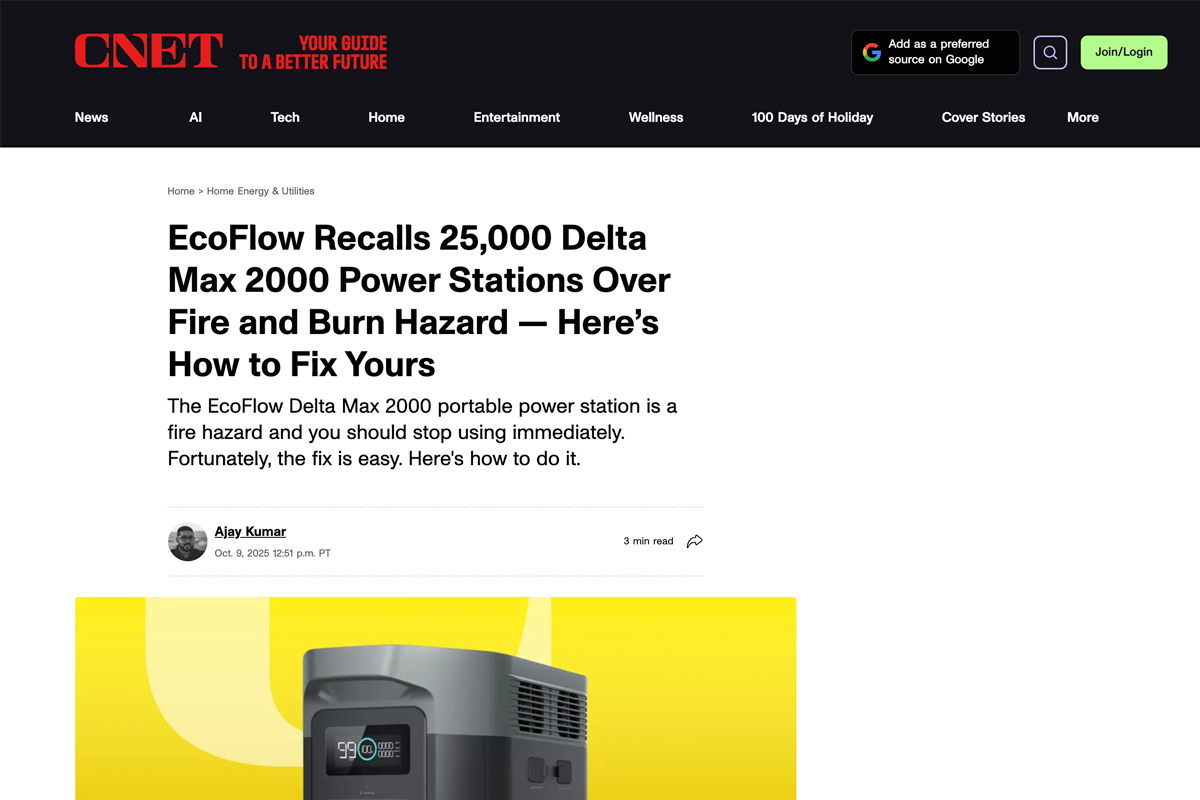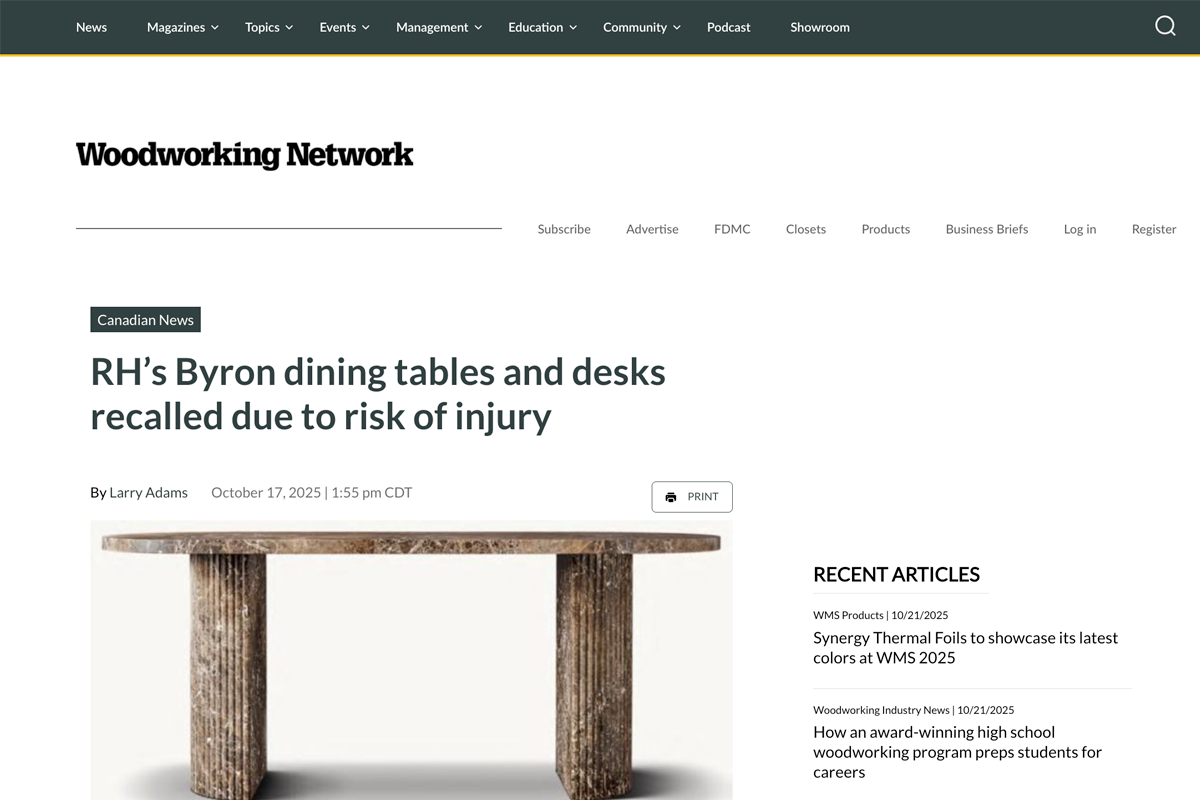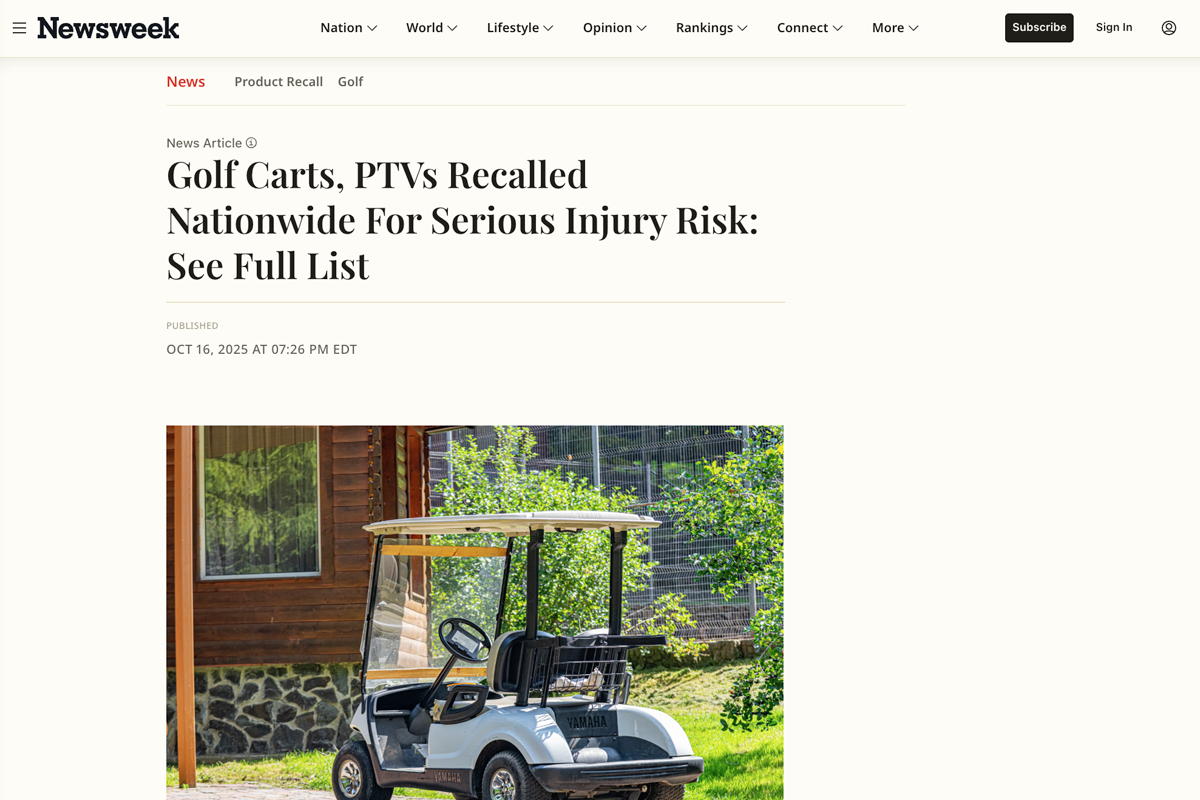October runs hot. Pocketable gadgets smolder, wall-powered gear misbehaves where doors, ducts, and consoles meet heat, and vehicles remind us how small omissions ripple into busy spaces. A few welds and joints call it quits under real loads, while kid gear and clinical tools expose the quiet failures of access control and visibility. None of this is exotic. It is energy looking for an exit and interfaces aging faster than their spec sheets. Read the month as a tour of thin margins, and you will see why the headlines keep catching fire.
Lithium-ion batteries linger on the list
Each month, portable lithium-ion batteries are inevitably recalled. ESR’s HaloLock wireless power banks, Zyntony’s Kogalla power banks, Anker power banks, Living Glow portable waist fans, IcyBreeze Buddy portable misting fans, and Arizer Solo II portable vaporizers were all recalled for fire or burn hazards tied to lithium-ion batteries. EcoFlow’s Delta Max 2000 power stations were recalled for overheating and ignition risk. These recalls are a testament to the sheer volume of lithium-ion battery powered devices that are sold on a daily basis. The Kogalla power banks represent the low end, with 2,400 devices impacted. In the middle, EcoFlow’s Delta Max 2000 lands near 25,030 and Living Glow’s portable waist fans sit around 48,000. Anker’s power bank recall, which encompasses five models, spans a whopping 481,000 units.

The concentration of portable products with overheating language signals a category risk where compact packaging, varied charge profiles, and real-world usage stack the deck against thermal margins. These parts might pass inspection initially, but for devices that live in pockets, bags, and hot rooms, reliability is key.
One more entry belongs here even though it plugs in. iFIT’s NordicTrack rowing machines report screen console electronics that can overheat and ignite, about 44,800 units in the United States and about 700 in Canada. It is a reminder that small, insulated electronics mounted on larger mains-powered products can face the same overheating risks as portable devices.
Seams under stress
Where heat and load meet, weak links show themselves. Sunbeam’s Oster French Door countertop ovens carry a burn hazard when doors can close unexpectedly, with about 1,290,000 units in the United States and about 104,195 in Canada affected. VESTA.DS VST tankless water heaters can crack at the exhaust duct and release gases, including carbon monoxide, indoors, about 36,700 units in the United States, plus 3,500 Canadian sales. RH’s Byron tables and desks can collapse when a gap opens at the leg to top interface, about 750 units, and Super Wheels’ Vaast A/1 bicycle frames can fracture near a weld, about 1,860 units.
Ordinary parts can have extraordinary consequences. Doors that drift, ducts that fatigue, and welds that see side loads become the story once heat and cycling pile up. Whether the tally is a million units or a few hundred, the same pattern appears: failures concentrate at thermal interfaces and load-bearing joints. This is familiar physics at work, with thin margins revealed by use, time, and temperature.

Hazards at any speed
Here the risks meet bystanders. Textron E-Z-GO personal transportation vehicles can leak gasoline at a quick-connect near the injector, about 90,800 units in the United States plus Canadian sales. Yamaha fields two golf car campaigns, one for missing stop lights in about 19,300 vehicles from model years 2021 to 2025, and one for potential brake failure in about 4,300 vehicles from model years 2017 to 2024. Wilteexs bioethanol fuel bottles lack flame-mitigation devices and carry “Non Toxic” claims, about 1,100 units, raising flash-fire risk. Different mechanics, same exposure: small misses in connectors and signals become public hazards in parking lots, paths, and garages.
These are ordinary environments, which makes them unforgiving. Parking lots, paths, and garages leave little separation between a small defect and a person. People read cues by habit; they assume brake lights exist and fuel stays contained. When those assumptions fail, risk extends beyond the user to everyone nearby. Small configuration splits across trims, suppliers, or model years can escape notice until they show up in the field. Fuel containers sit under the same quiet expectation, and without flame mitigation a routine pour can turn into a flash event.

Small batteries, big risks
Two children’s products turn on a single access point. About 740 LED tutu skirts sold by Bmrwtg allow easy access to coin cells and lack the warnings required by Reese’s Law. About 3,000 Youbeien crib mobiles have remotes whose battery doors can be opened without a common household tool. The scale is modest compared with appliance recalls, but the hazard is concentrated and severe. Small parts compliance is binary, and real-world handling includes repeated openings, flex, and pry attempts by curious kids. Battery enclosures and labeling must be treated as safety-critical, with lot-to-lot checks and post-use fit tests.
Patient safety at stake
Two medical device recalls sit squarely on reliability at the point of care. On September 22, 2025, Olympus flagged ViziShot 2 FLEX 19G EBUS-TBNA needles for components that may detach during procedures. On October 7, 2025, Trividia Health recalled TRUE METRIX blood glucose meters for LCD defects that can affect performance. Unit counts are not stated here, but both products inform clinical decisions in real time, which raises the consequence of even limited populations. In practical terms, devices must keep their components secure and present clear, trustworthy readings. When either falters, clinicians lose signal or confidence at the moment they need it most.

Patterns worth testing
Look across October and the same physics keep showing up. Thermal headroom and honest derating decide whether packs and console boards stay uneventful. Containment and vent paths determine if fuel and exhaust stay where they belong. Doors, latches, ducts, and weld toes carry more safety load than their bill of materials suggests. On low-speed vehicles, stop lights and braking are the guardrails for shared space. In children’s products, safety turns on controlled access to coin cells and correct warnings. In clinical tools, it depends on parts that stay attached and displays that stay readable.
The misses rarely sit in the marquee component. They live in a hinge that lost hold-open force, a quick-connect that seeped under vibration, an exhaust duct that thinned with heat, a display interconnect that drifted, a battery door that loosened after use, a weld toe that carried side load. Treat this month as a map of where engineering time tends to matter most: thermal interfaces, joints under side load, basic vehicle signaling, and battery access. Use it to prioritize test time and supplier controls in the next build cycle.
Curious how I keep track of this constant barrage of recalls? Check out our new Recall Roundup tool to access a comprehensive database of product recalls, updated daily from CPSC and NHTSA records. We also discuss recalls in every episode of our podcast, Go/No-Go.




